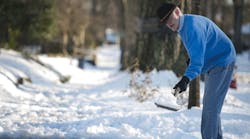According to the American Journal of Emergency Medicine, shoveling show accounts for more than 11,500 emergency-room visits each year.
Shoveling-related problems – whether they necessitate a trip to the ER or not – range from herniated discs and tendinitis to fractures and spinal-cord injuries. Studies also suggest that shoveling can elevate the risk of heart attacks.
When shoveling snow – not to mention dealing with icy roads trying to walk on slippery pavement – caution is the key word, according to Dr. Jeffrey Cole, director of electrodiagnostic and musculoskeletal medicine at Kessler Institute for Rehabilitation in New Jersey.
“Most people don’t recognize the dangers that snow and ice present, nor do they realize the amount of stress that shoveling combined with cold weather can put on the body,” Cole says. “For older and more sedentary individuals, the likelihood of injury is even greater. While we can’t prevent injuries, we can try to minimize that risk.”
Kessler Institute offers these tips for making snow-shoveling a safe winter activity:
- Avoid caffeine or nicotine before shoveling, especially if you have a history of or are at high risk for a heart attack. These stimulants can increase your heart rate and cause your blood vessels to constrict, which places extra stress on the heart. If you have a heart condition, respiratory issues or back problems, check with your doctor before doing any shoveling.
- Drink plenty of water to avoid dehydration.
- Dress in layers and be sure to wear a hat, gloves and sturdy, non-skid waterproof footwear. Avoid wearing scarves or hats that block your vision, and wear sunglasses or goggles to reduce glare.
- Move slowly and cautiously, and watch where you’re walking. What might look like wet pavement could be black ice, so be extra careful. When walking down stairs, plant your feet securely on each step and hold the handrail firmly.
- Before shoveling, warm up for about 10 minutes. Do some basic exercises to stretch your back, arms and legs, and walk or march in place. “Warm” muscles generally work more efficiently and are less likely to become injured.
- Try to shovel fresh snow, before it becomes packed or refrozen. It might be helpful to shovel a few times during a snowfall rather than waiting until the storm ends when the snow is deeper and heavier.
- If possible, try pushing the snow rather than lifting. When lifting, pick up small amounts of snow at a time using your legs, not your back. Scoop the snow in a forward motion and step in the direction as you throw the snow. Avoid twisting and tossing the snow over your shoulder or to the side.
- Switch hands periodically and alternate the side to which you’re throwing snow to more evenly distribute the workload and repetitive muscle use.
- Use a sturdy snow shovel that has open ends to allow you to easily toss the snow to the side.
- Pace yourself. Be sure to take frequent breaks to rest and avoid overexertion. Exhaustion can make you more susceptible to injury, hypothermia and frostbite.
Most importantly, if you begin to experience any pain in your chest, arm or neck, shortness of breath or profuse sweating, stop shoveling immediately and seek emergency medical attention.
